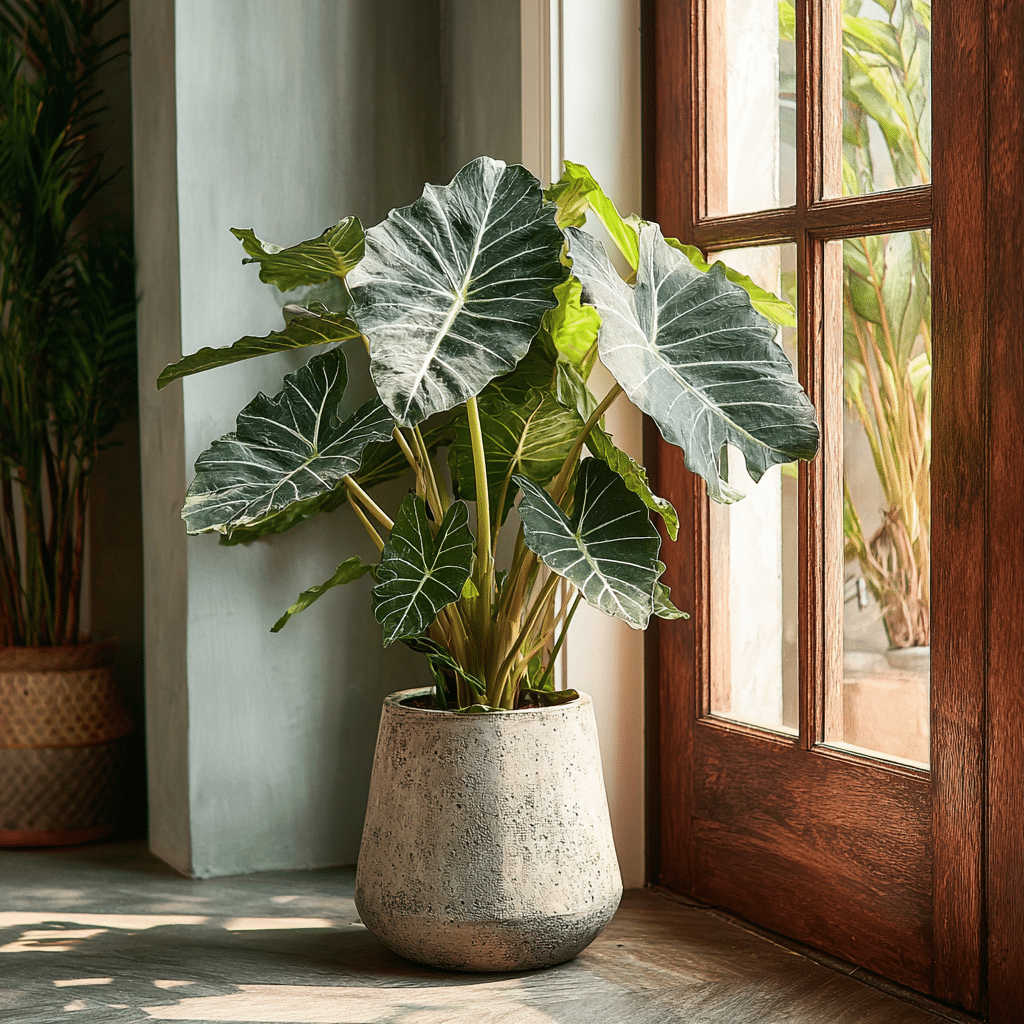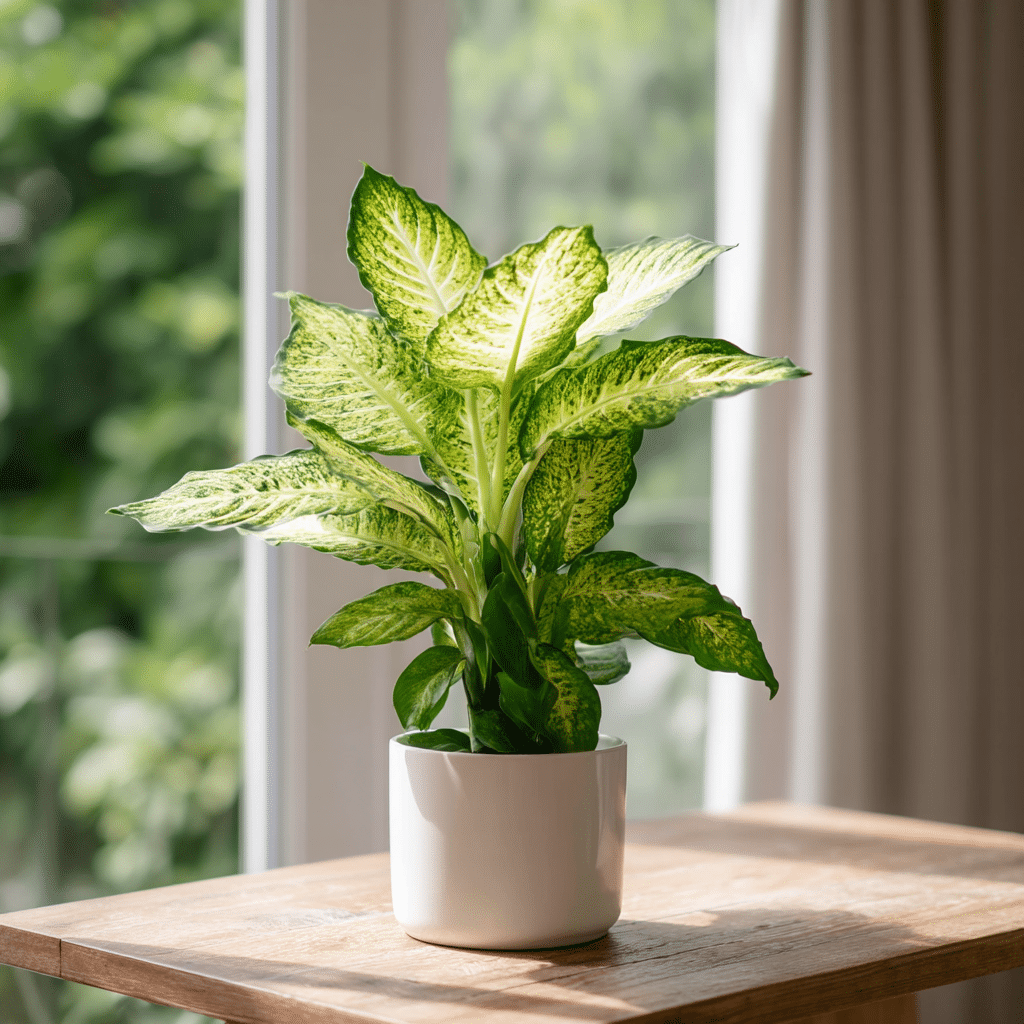Tropical plants add a lush, vibrant touch to any indoor space, bringing warmth and greenery that feel like a slice of paradise. Whether you’re a seasoned houseplant lover or just starting your plant journey, there’s a wide variety of tropical foliage that can thrive inside your home with the right conditions.
From bold statement plants like Monstera and Bird of Paradise to smaller, easier options like the ZZ Plant or Peace Lily, the best tropical plants for indoors come in all shapes, sizes, and maintenance levels. The key is to match your home’s light, humidity, and space with the right plant variety. With proper care—and a little patience—you can create a thriving indoor jungle no matter where you live.
In this guide, we’ll walk through 20 tropical houseplants that are not only beautiful but also surprisingly adaptable to indoor life.
Table of Contents
1. Dieffenbachia (Dumb Cane)
If you’re looking for tropical plants with bold foliage and minimal fuss, Dieffenbachia is a great place to start. Known for its large, variegated leaves in striking shades of green and creamy white, this plant can easily become a focal point in your living room or office.
Dieffenbachia thrives in bright, indirect light, though it can tolerate lower light levels. It prefers a warm environment, ideally above 60°F, and does best in a fast-draining potting mix. Keep the soil slightly moist, allowing the top inch to dry out between waterings.
Although easy to grow, it’s important to handle this plant with care—its sap can be irritating to skin and is toxic to pets and humans if ingested. Wearing gloves when pruning or repotting is a good precaution.
Quick Care Tips:
- Light: Bright, indirect light
- Water: When top inch of soil is dry
- Size: 3–10 ft. tall, 2–3 ft. wide
- Difficulty: Low-maintenance
- Toxicity: Toxic to people and pets
2. Orchids (Orchidaceae)
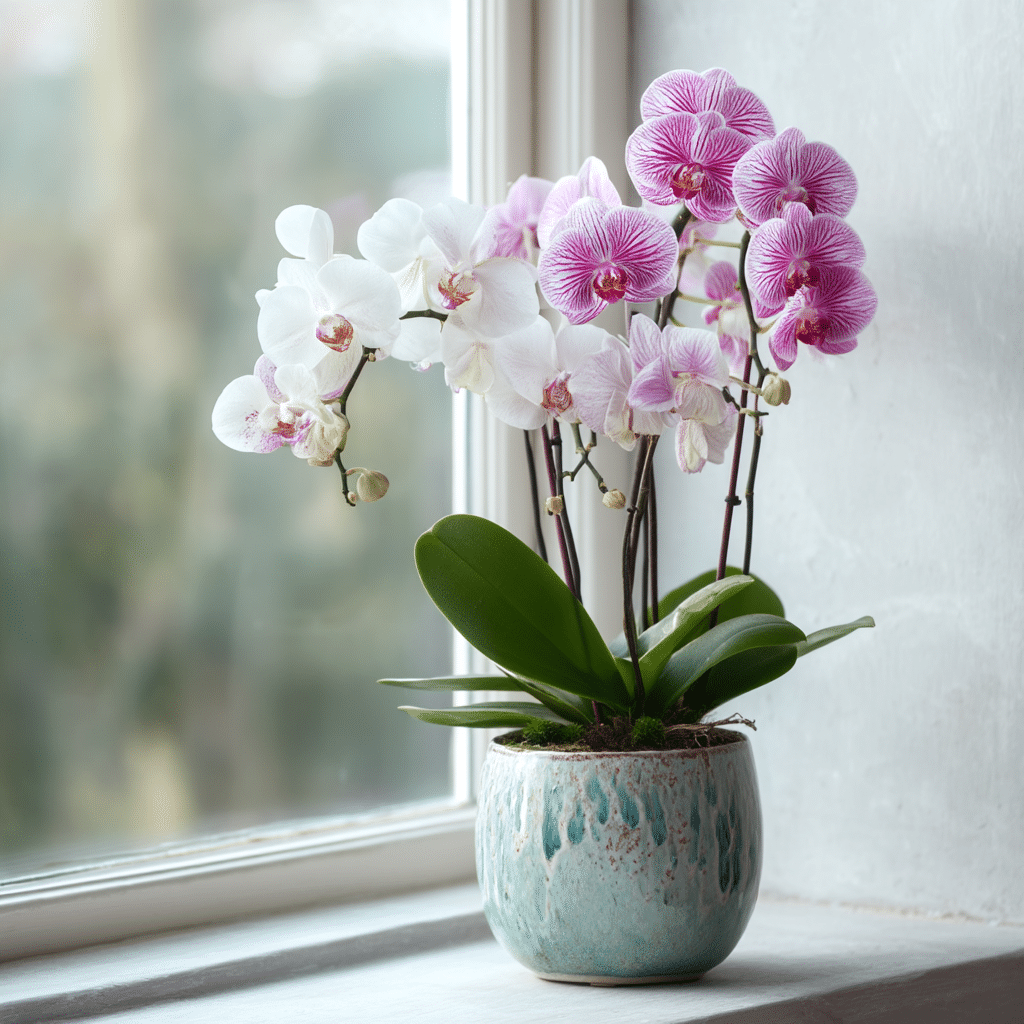
Among all tropical plants, orchids might be the most iconic. With their exotic blooms in shades of white, pink, yellow, purple, and even variegated patterns, they add instant elegance to any indoor space. While they have a reputation for being finicky, many orchid varieties are more forgiving than people think—especially when you understand their needs.
Orchids prefer bright, indirect light and thrive in a warm, humid environment. Avoid placing them in direct sunlight or near drafts, as this can stress the plant. Watering should be done sparingly; let the potting medium dry out slightly between waterings to prevent root rot.
Most indoor orchids are epiphytes, meaning they grow naturally on trees, not in soil. Use a specialized orchid mix that allows for plenty of airflow around the roots. With the right care, an orchid can bloom for weeks—or even months.
Quick Care Tips:
- Light: Bright, indirect
- Water: Let medium dry slightly between waterings
- Size: 1–3 ft. tall, 6–12 in. wide
- Difficulty: Moderate to high
- Toxicity: Generally non-toxic
3. Bromeliads (Bromeliaceae)
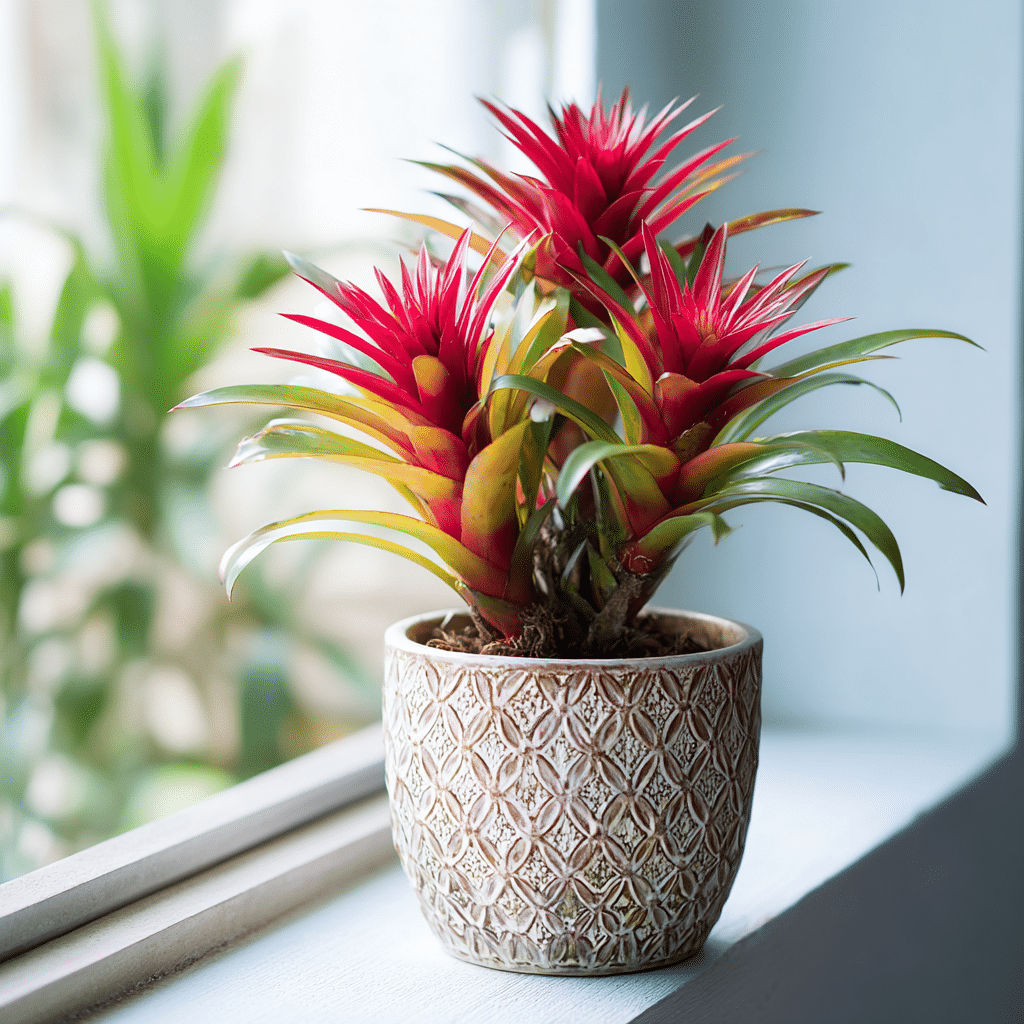
When it comes to tropical plants that are both colorful and easy to grow, bromeliads top the list. These unique plants come in a wide range of colors and leaf patterns—red, orange, purple, green, and even stripes—and they bring a distinctly tropical feel to any indoor space.
Bromeliads are epiphytes by nature, like orchids, and don’t require traditional soil to thrive. You can pot them in a fast-draining mix (such as peat and sand) or even mount them on wood. Their central “cup” collects water in the wild, and indoors, you can mimic this by filling the rosette with fresh water—just be sure to empty and refill it weekly to prevent bacteria buildup.
These resilient plants do well in bright, indirect light and don’t mind occasional neglect, making them perfect for busy plant lovers or beginners.
Quick Care Tips:
- Light: Bright, indirect
- Water: Keep soil lightly moist; refill central cup weekly
- Size: Varies widely by species
- Difficulty: Low-maintenance
- Toxicity: Generally safe for pets
4. Fiddle Leaf Fig (Ficus lyrata)
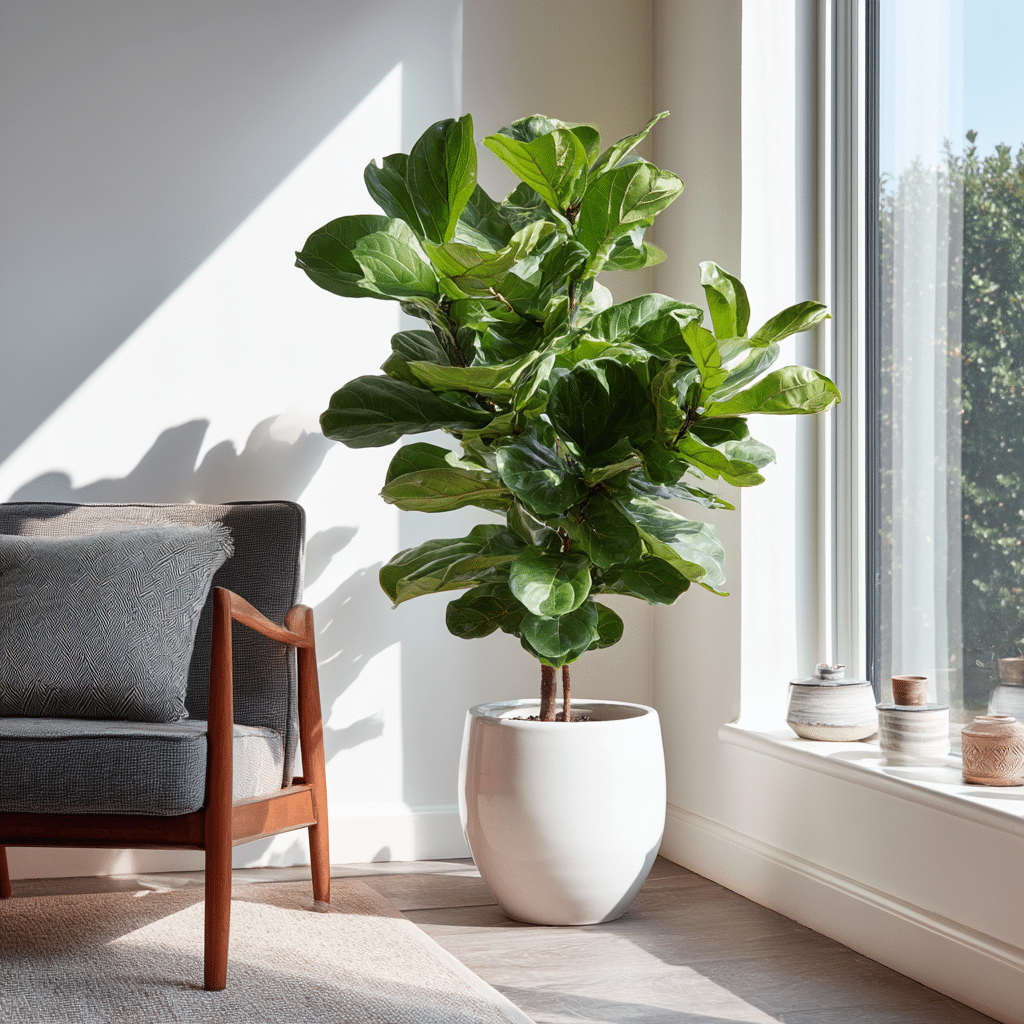
Few tropical plants have made as big a splash in interior design as the Fiddle Leaf Fig. With its large, glossy, violin-shaped leaves, it’s a statement piece that can instantly elevate any room. Native to western Africa, this plant thrives indoors when given the right care—and space.
Fiddle Leaf Figs prefer bright, indirect light and dislike sudden changes in environment. Find a stable spot near a sunny window and avoid cold drafts or moving it too often. Rotate the pot regularly so all sides receive even light. Water when the top inch of soil feels dry, but avoid letting the roots sit in water.
While undeniably beautiful, this plant can be temperamental. Yellowing leaves or brown edges usually signal issues with watering or humidity. And keep in mind—it’s toxic to both people and pets if ingested.
Quick Care Tips:
- Light: Bright, indirect
- Water: When top inch of soil is dry
- Size: 6–10 ft. tall, 3–4 ft. wide (indoors)
- Difficulty: High-maintenance
- Toxicity: Toxic to humans and pets
5. Ponytail Palm (Beaucarnea recurvata)
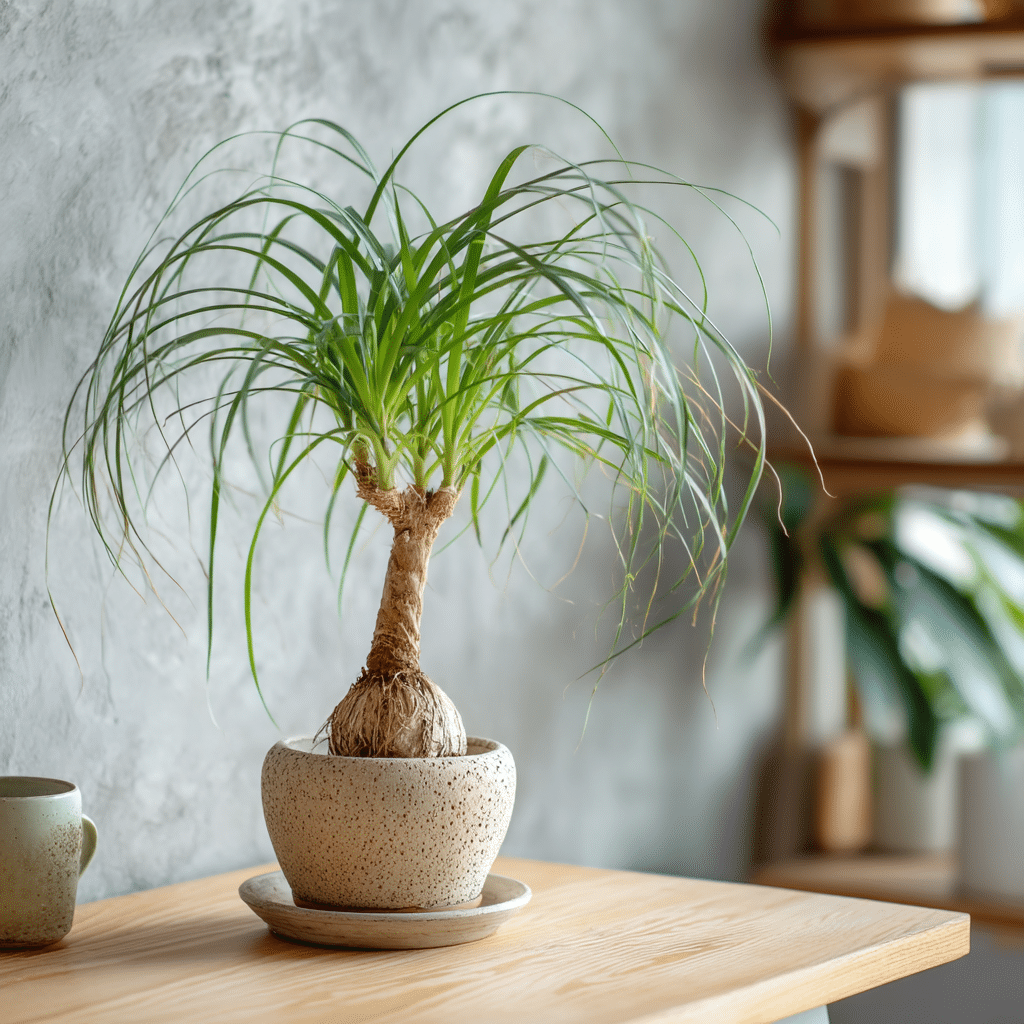
Despite its name, the Ponytail Palm isn’t a true palm—but it sure looks like one. With its thick, bulbous trunk and long, strappy green leaves that cascade like a ponytail, this quirky plant adds a fun, sculptural touch to any indoor space. It’s also one of the easiest tropical plants to care for, making it a favorite among beginners.
The swollen base stores water, so you won’t need to worry about frequent watering. In fact, it’s more tolerant of neglect than overwatering. Water every 1–2 weeks, allowing the soil to dry completely between waterings. It prefers bright, indirect light but can adapt to lower-light conditions.
Best of all, the Ponytail Palm is non-toxic, so it’s a safe choice for homes with pets or small children.
Quick Care Tips:
- Light: Bright, indirect; tolerates low light
- Water: Every 1–2 weeks; let soil dry out
- Size: 3–6 ft. tall and wide
- Difficulty: Very low-maintenance
- Toxicity: Non-toxic
6. Philodendron
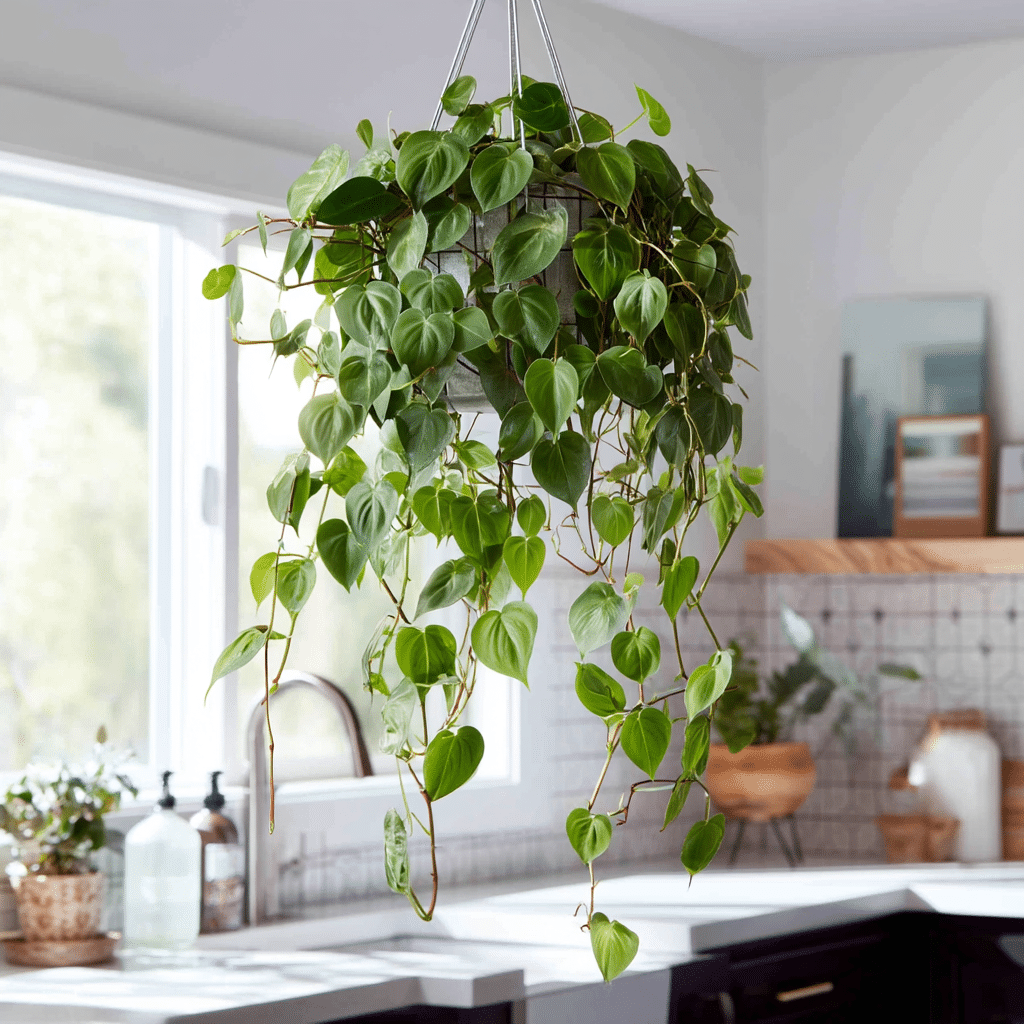
Philodendrons are some of the most adaptable and forgiving tropical plants you can grow indoors. With their lush green leaves and trailing or upright growth habits, they’re a go-to choice for anyone looking to create a jungle vibe inside their home.
There are two main types: vining varieties like the heartleaf philodendron that look great in hanging baskets, and self-heading types with a more compact, bushy growth. Both types enjoy medium, indirect light, and appreciate consistently moist—yet not soggy—soil. During winter, reduce watering as growth slows.
Philodendrons are relatively low-maintenance but should be kept out of reach of pets and children, as they contain calcium oxalate crystals that are toxic if ingested.
Quick Care Tips:
- Light: Medium, indirect
- Water: Keep soil lightly moist
- Size: 1–20 ft. tall, 1–6 ft. wide (depending on variety)
- Difficulty: Low-maintenance
- Toxicity: Toxic to people and pets
7. Monstera (Monstera deliciosa)
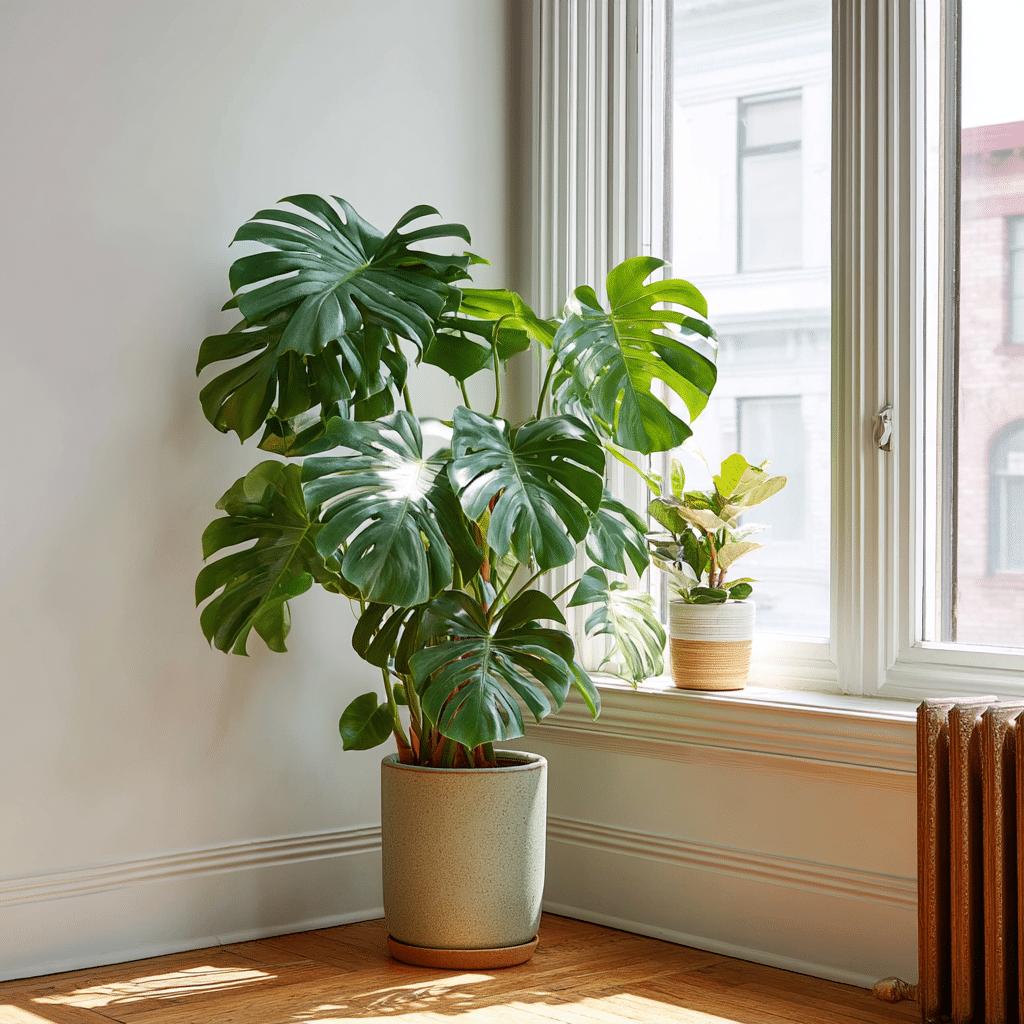
If you’ve scrolled through any home decor feed lately, chances are you’ve seen a Monstera. Nicknamed the Swiss cheese plant for its large, hole-punched leaves, Monstera is one of the most eye-catching and Instagram-worthy tropical plants you can grow indoors.
Monstera thrives in bright, indirect light, although it can tolerate some lower light. The more light it receives (without being scorched by direct sun), the more its leaves will split and develop those iconic fenestrations. Water when the top 1–2 inches of soil are dry, and provide a support pole if you want it to climb like it does in the wild.
With regular watering and occasional misting, Monstera will reward you with vigorous growth and a lush, tropical vibe that’s hard to beat.
Quick Care Tips:
- Light: Bright, indirect
- Water: Let top 1–2 inches dry out
- Size: 3–15 ft. tall, 3–8 ft. wide (indoors)
- Difficulty: Low-maintenance
- Toxicity: Toxic to pets and humans
8. Peace Lily (Spathiphyllum)
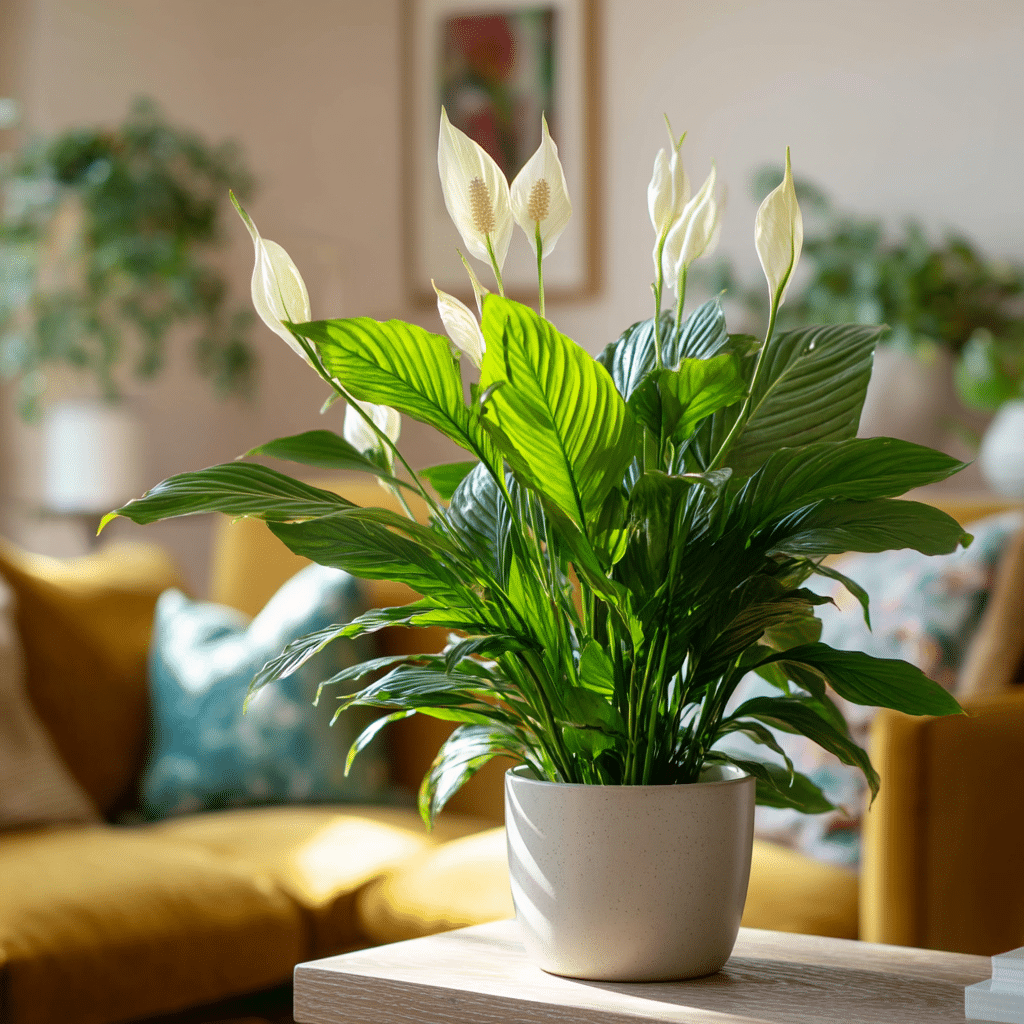
Peace lilies are a classic choice among tropical plants thanks to their glossy leaves and graceful white blooms that resemble calla lilies. Although they bloom more readily in the right conditions, even when not flowering, peace lilies make attractive and air-purifying additions to your home.
These plants prefer medium, indirect light, though they can tolerate low-light areas—just expect fewer blooms. Keep the soil evenly moist, but avoid letting the roots sit in water. They’ll quickly let you know if they’re thirsty with droopy leaves that perk up again after watering.
Despite their peaceful appearance, peace lilies are toxic to pets and humans if ingested, so place them out of reach if needed.
Quick Care Tips:
- Light: Medium, indirect; low light tolerated
- Water: Keep soil evenly moist
- Size: 1–4 ft. tall and wide
- Difficulty: Moderate
- Toxicity: Toxic to pets and people
9. Anthurium (Anthurium andraeanum)
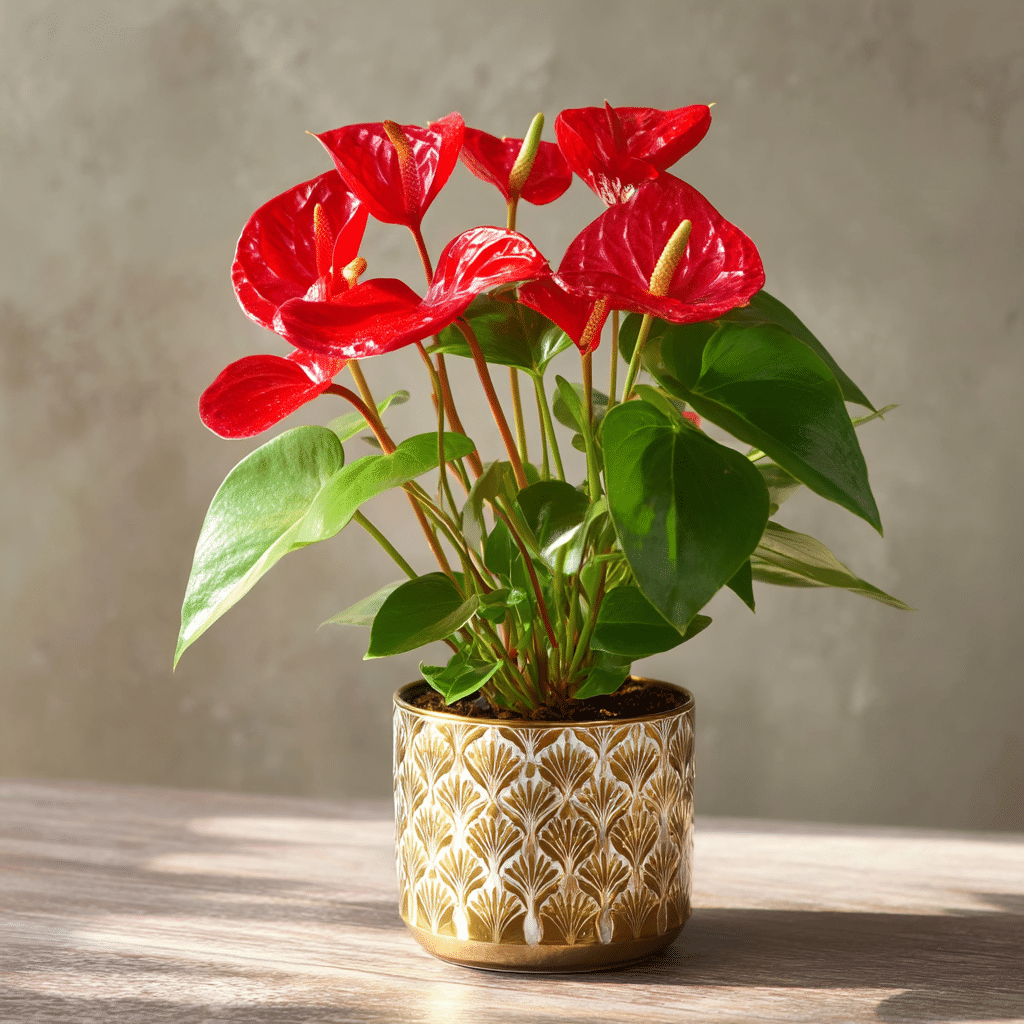
If you’re after tropical plants with bold color, Anthurium delivers. Famous for its striking red or pink waxy “flowers” (technically spathes), this plant adds a splash of tropical drama to any space. The bright color and shiny leaves make it a standout in modern interiors or plant collections.
Anthuriums prefer bright, indirect light, warm temperatures, and high humidity. They’re happiest in a loose, well-draining potting mix rich in organic matter. Water them regularly, but avoid letting the roots sit in water—consistently damp, not soggy, is the goal.
This plant is not the easiest to grow indoors, but it’s incredibly rewarding when thriving. Keep in mind, Anthuriums are toxic to pets and people, so caution is key if you have curious animals or small children.
Quick Care Tips:
- Light: Bright, indirect
- Water: Keep soil moist but not wet
- Size: 12–18 in. tall, 9–12 in. wide
- Difficulty: High
- Toxicity: Toxic to humans and pets
10. Schefflera (Schefflera arboricola)
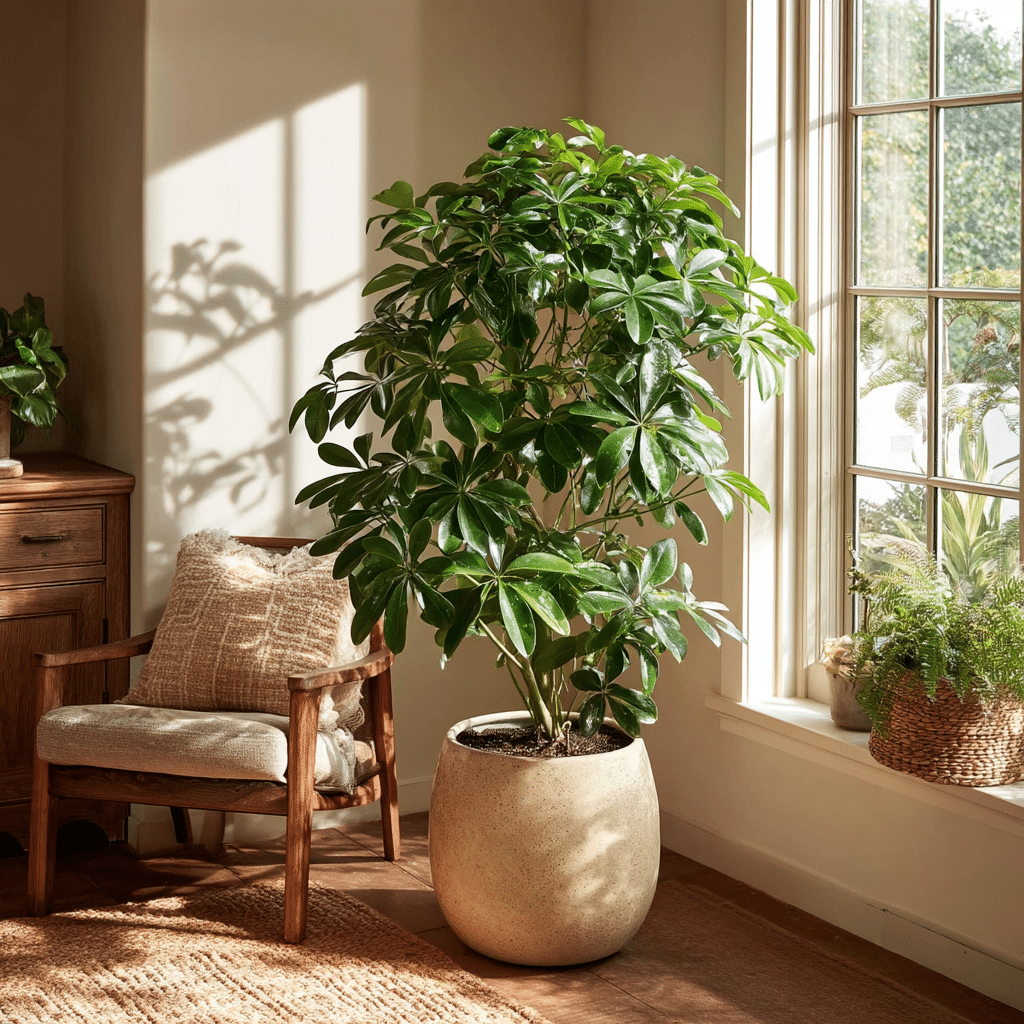
Schefflera, also known as the umbrella plant, is a bushy and resilient member of the tropical plants family, named for its glossy, umbrella-like leaf clusters. It’s a popular indoor plant thanks to its fast growth and ability to fill a space with lush, green foliage.
To keep a Schefflera healthy indoors, place it in bright, indirect light—too little light can cause leggy growth, while direct sun can scorch its leaves. It enjoys warmth and humidity, so avoid cold drafts or dry air. Water when the top inch of soil feels dry, and ensure your pot has good drainage.
Schefflera is relatively easy to care for but does require regular pruning to keep its shape. Be aware that it is toxic if ingested by pets or humans.
Quick Care Tips:
- Light: Bright, indirect
- Water: When top inch of soil is dry
- Size: 4–6 ft. tall, 3–6 ft. wide (indoors)
- Difficulty: Moderate
- Toxicity: Toxic to people and pets
11. Ficus (Ficus benjamina)
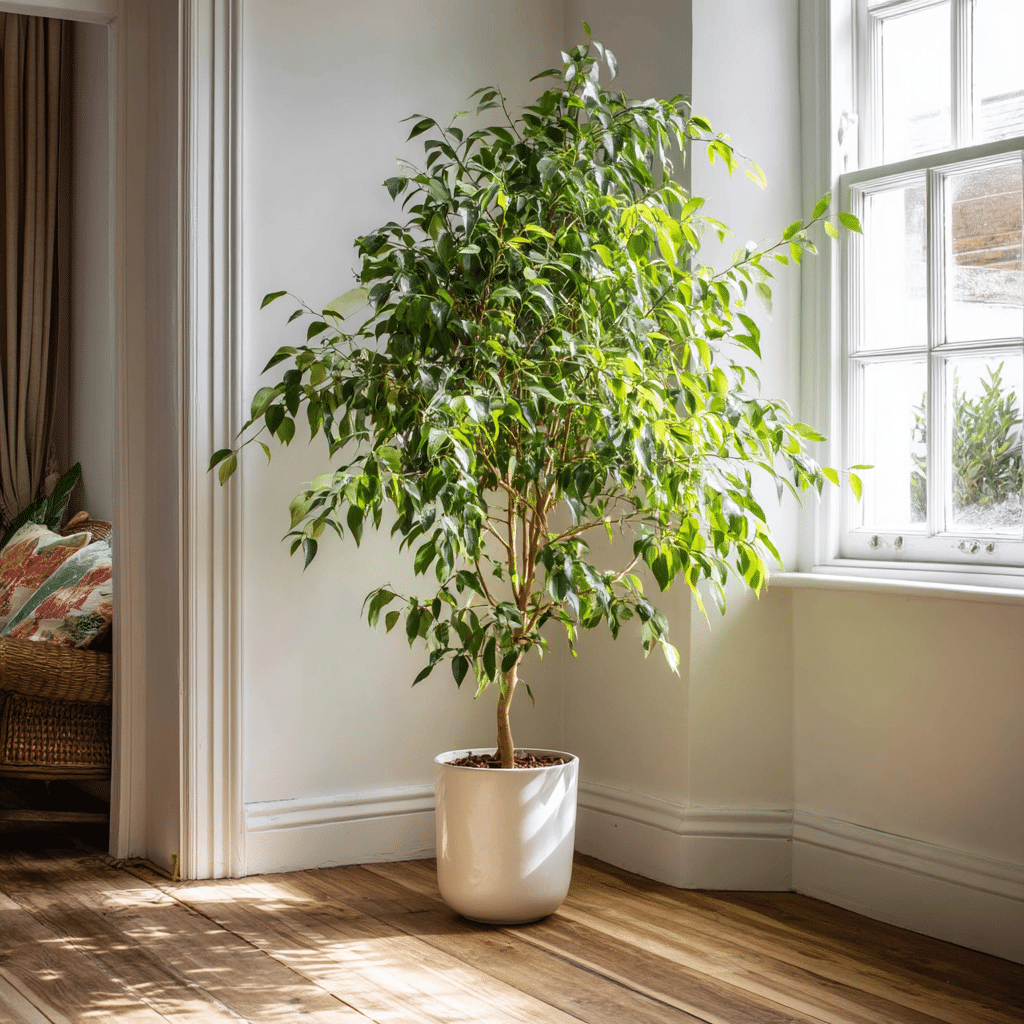
A longtime staple among tropical plants, the Ficus—commonly known as the Weeping Fig—brings height and elegance to indoor spaces. With its slender branches and glossy green leaves, it’s ideal for adding a touch of sophistication to living rooms, offices, or entryways.
Ficus plants require bright, indirect light and consistent care. They can be a bit fussy—sensitive to changes in light, temperature, and placement. It’s common for a Ficus to drop leaves after being moved, but once it settles in a good spot, it will thrive. Water when the top inch or two of soil is dry, and avoid cold drafts.
Regular pruning helps maintain shape and prevent legginess. Like many indoor tropicals, Ficus is toxic to pets and humans due to its sap.
Quick Care Tips:
- Light: Bright, indirect
- Water: Allow top 1–2 inches to dry
- Size: Up to 6 ft. tall indoors
- Difficulty: Moderate to high
- Toxicity: Toxic to pets and people
12. ZZ Plant (Zamioculcas zamiifolia)
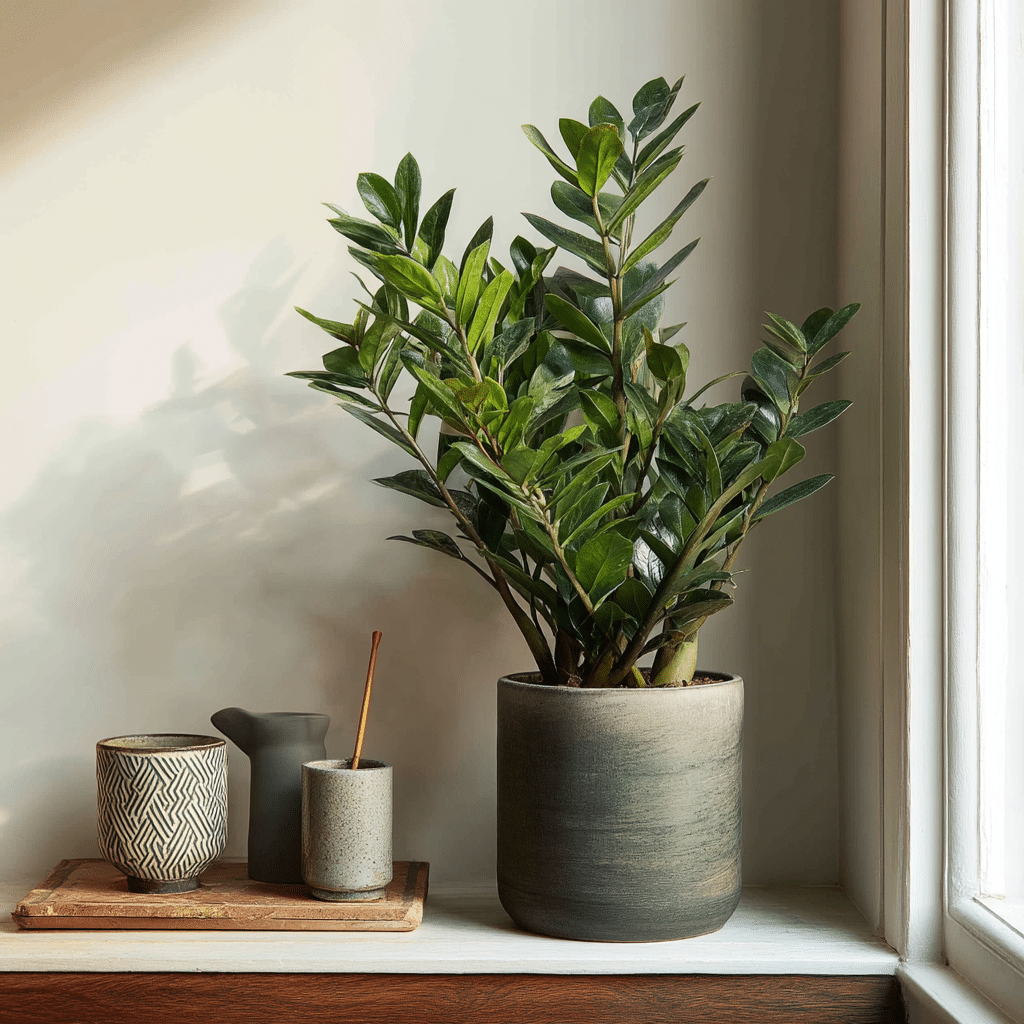
If you’re searching for tropical plants that are nearly impossible to kill, the ZZ Plant is your answer. With its thick, waxy, dark green leaves and upright stems, this plant adds a polished look to any room while asking for very little in return.
The ZZ Plant thrives in low to moderate light but does best in bright, indirect light. It’s drought-tolerant thanks to its rhizomes, which store water—so overwatering is the only real way to harm it. Let the soil dry out completely between waterings.
Its slow-growing nature and tolerance of low humidity make it ideal for busy homes or office spaces. Just note: it’s toxic if ingested, so keep it away from pets and small children.
Quick Care Tips:
- Light: Bright, indirect to low light
- Water: Let soil dry out completely
- Size: 2–4 ft. tall and wide
- Difficulty: Very low-maintenance
- Toxicity: Toxic to pets and people
13. Kentia Palm (Howea forsteriana)
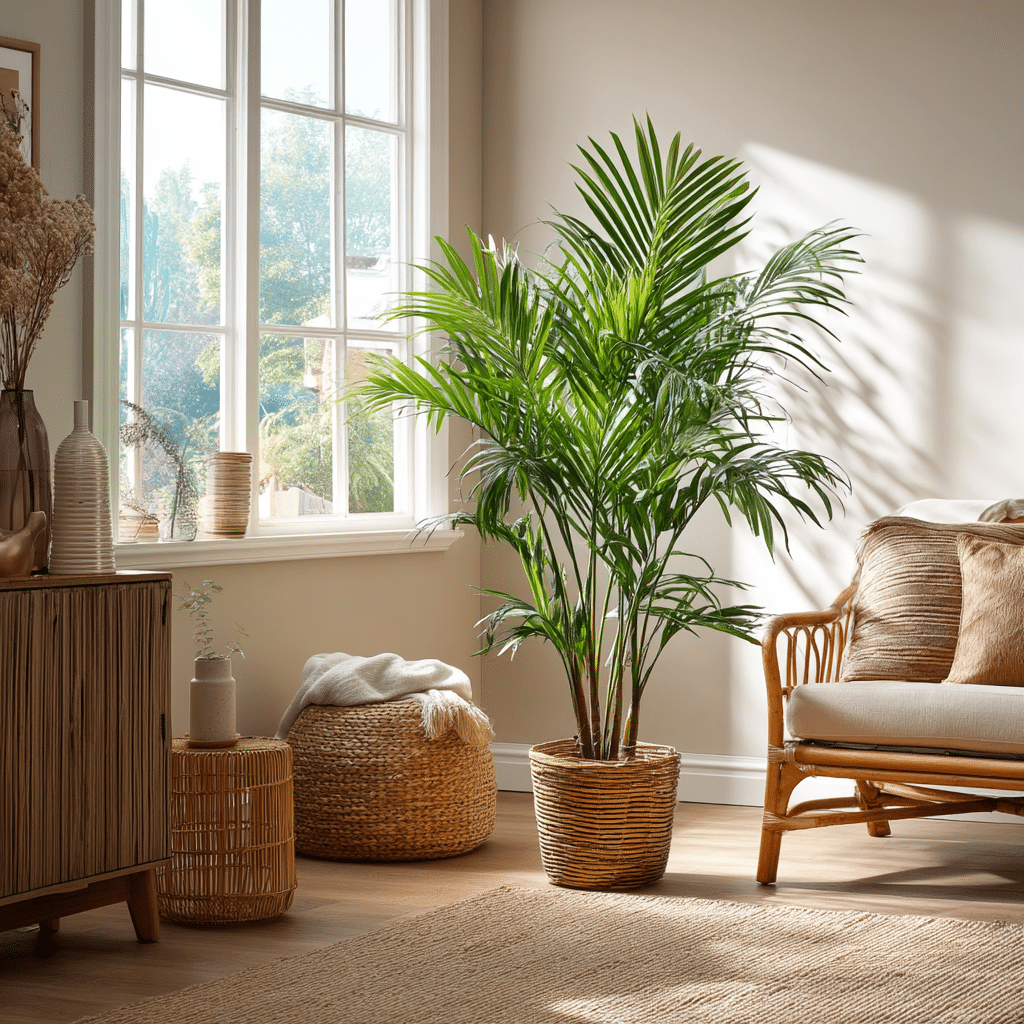
Elegant and slow-growing, the Kentia Palm brings a refined, resort-like feel to interiors. As one of the most adaptable tropical plants, it’s perfect for adding vertical greenery to corners, entryways, or bright living spaces.
This palm thrives in filtered, bright light, though it can tolerate lower light conditions better than many other palms. It prefers a well-draining potting mix and should be watered weekly during the growing season, allowing the top of the soil to dry between waterings. Avoid overwatering, especially in winter.
Kentia Palms are prized for their ability to grow indoors without demanding high humidity or constant attention. Plus, they’re generally considered non-toxic, making them safer for pet owners.
Quick Care Tips:
- Light: Filtered bright light; tolerates low light
- Water: Weekly in summer; let soil dry slightly
- Size: Up to 10 ft. indoors
- Difficulty: Low-maintenance
- Toxicity: Non-toxic
14. Cordyline (Cordyline fruticosa)
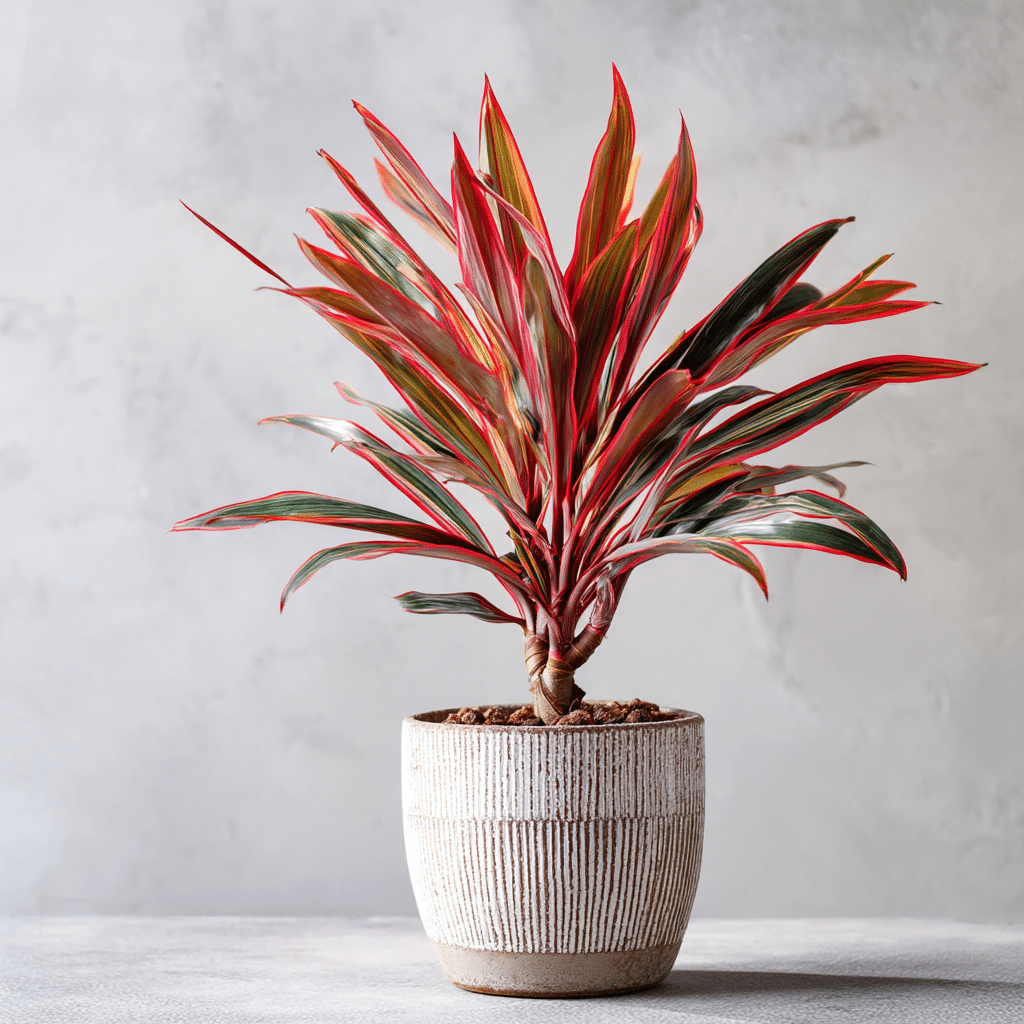
Few tropical plants offer the bold, dramatic foliage of Cordyline, also known as the Hawaiian Ti Plant. With its striking leaves in shades of red, pink, purple, green, and even yellow, this plant brings a splash of island color to any indoor space.
Cordyline prefers bright, indirect light and thrives in warm, humid environments. It does best in rich, well-draining soil with a slightly acidic pH (around 6.0–6.5). Keep the soil consistently moist during the growing season but ease up on watering during winter.
It’s a great choice for bathrooms, kitchens, or other humid rooms. Just be cautious—Cordyline is toxic to cats and dogs if ingested.
Quick Care Tips:
- Light: Bright, indirect
- Water: Keep consistently moist (not soggy)
- Size: 3–6 ft. tall and wide
- Difficulty: Moderate
- Toxicity: Toxic to pets
15. Watermelon Peperomia (Peperomia argyreia)
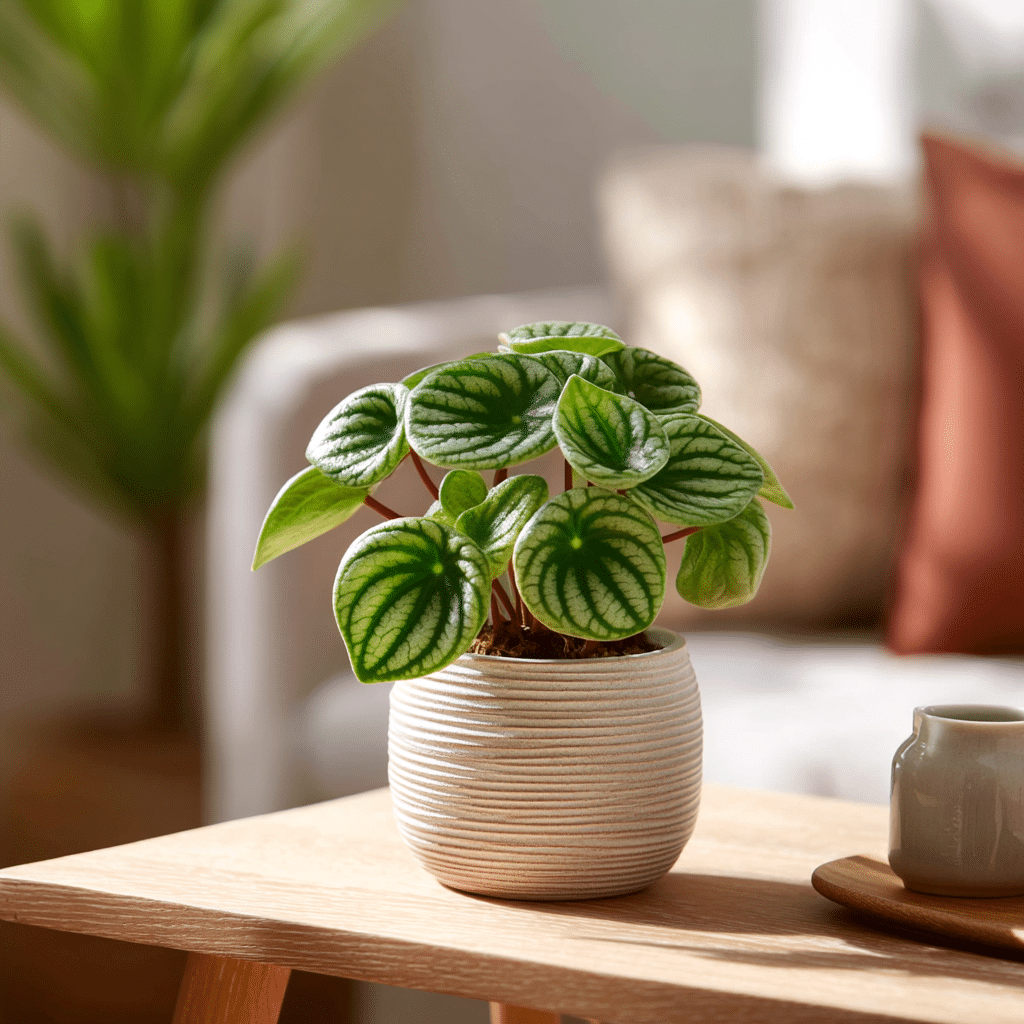
With its round, striped leaves that look remarkably like watermelon rinds, the Watermelon Peperomia is one of the most eye-catching tropical plants for small spaces. It stays compact and tidy, making it a great choice for desks, shelves, or windowsills.
This plant thrives in bright to medium indirect light. Direct sun can scorch its delicate foliage, while too little light may cause the leaves to lose their vibrant patterns. Water when the top inch of soil is dry, and always ensure proper drainage to avoid root rot.
Its modest size and low-maintenance nature make it especially appealing for plant beginners or apartment dwellers. Plus, it’s generally non-toxic, which is a bonus for homes with pets or kids.
Quick Care Tips:
- Light: Bright to medium indirect
- Water: When top inch of soil is dry
- Size: Up to 12 in. tall, 8 in. wide
- Difficulty: Low-maintenance
- Toxicity: Non-toxic
16. African Violet (Saintpaulia ionantha)
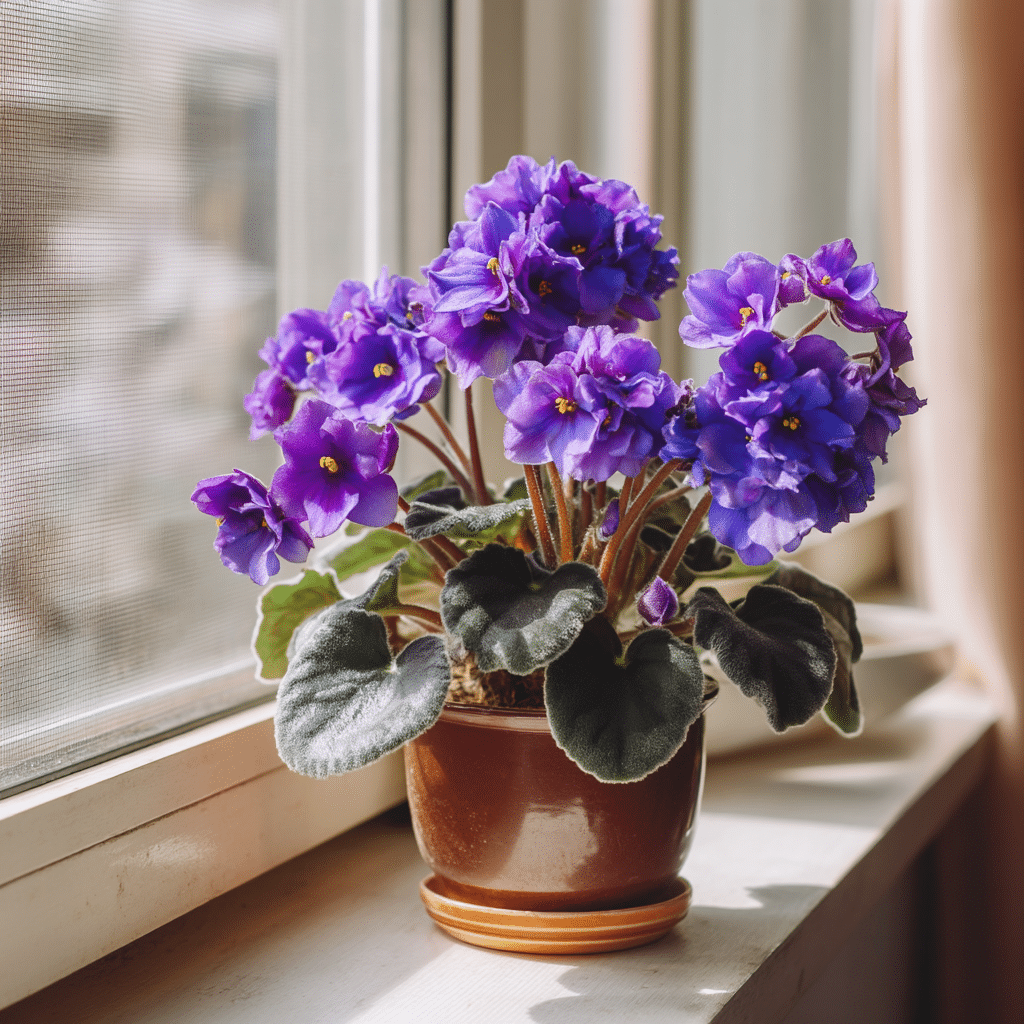
A favorite among indoor gardeners, the African Violet is one of the few tropical plants that blooms reliably indoors year-round. With fuzzy green leaves and clusters of delicate purple, pink, or white flowers, it adds a soft, colorful charm to windowsills and small tables.
African Violets prefer bright, indirect light, ideally from an east- or north-facing window. Avoid direct sunlight, which can scorch the leaves. They also need warm temperatures and high humidity, along with well-draining, African violet-specific potting soil. Keep the soil evenly moist, but avoid getting water on the leaves to prevent spotting.
They’re a bit more particular than other houseplants but rewarding with proper care. African Violets are generally considered non-toxic, making them a pet-friendly flowering option.
Quick Care Tips:
- Light: Bright, indirect
- Water: Keep soil evenly moist; avoid wetting leaves
- Size: 6–9 in. tall and wide
- Difficulty: Moderate
- Toxicity: Non-toxic
17. Bird of Paradise (Strelitzia reginae)
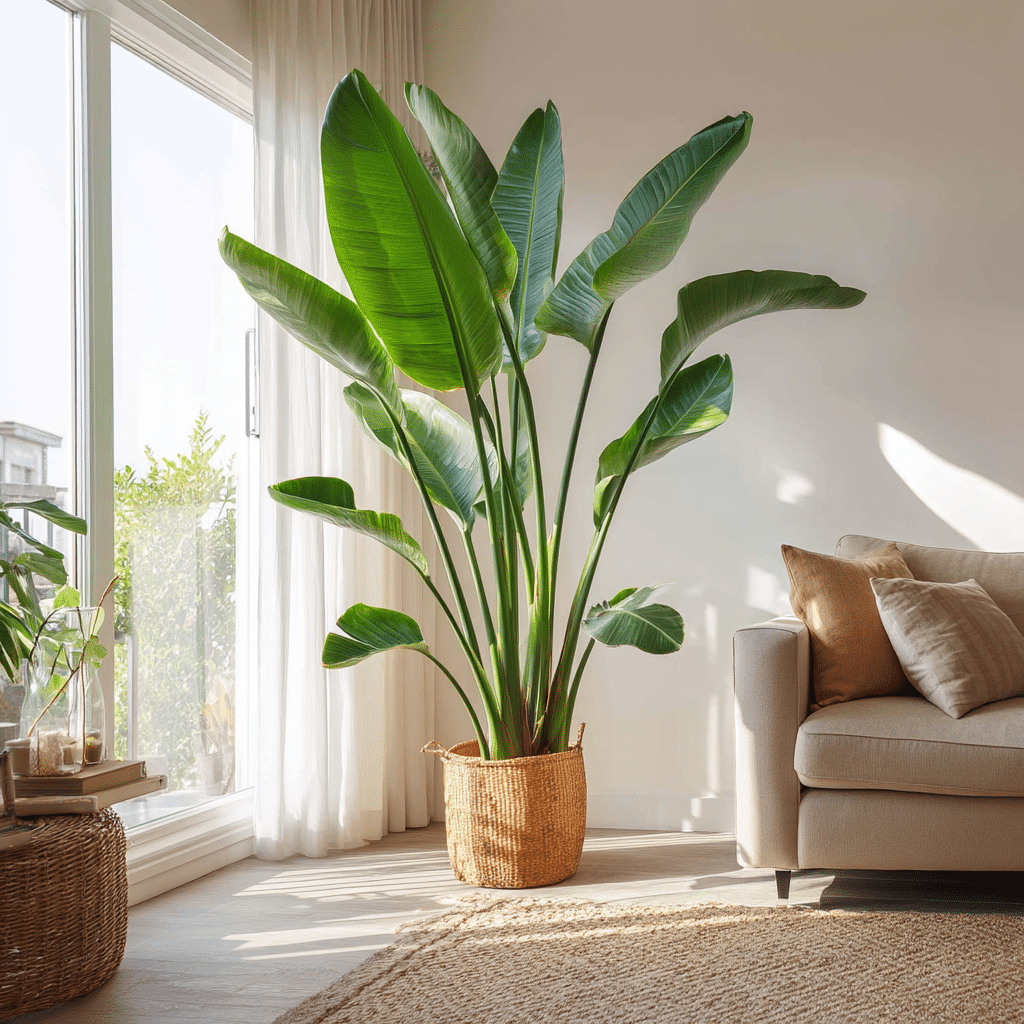
For indoor gardeners looking to bring serious tropical flair into their home, the Bird of Paradise is a showstopper. Known for its large, banana-like leaves and bold stature, this plant can create a lush, resort-like feel in any bright corner of your space. While it rarely flowers indoors, its foliage alone makes it one of the most popular tropical plants for interiors.
Bird of Paradise thrives in bright light, including a few hours of direct sunlight each day. Without adequate light, growth will slow significantly. Water regularly during the growing season, allowing the top few inches of soil to dry out between waterings. It also benefits from high humidity and regular feeding.
This plant is toxic to cats and dogs, so placement matters if you share your space with pets.
Quick Care Tips:
- Light: Bright light, some direct sun
- Water: Keep soil moderately moist
- Size: 3.5–6 ft. tall, 3–4 ft. wide
- Difficulty: Low-maintenance
- Toxicity: Toxic to pets
18. Prayer Plant (Maranta leuconeura)
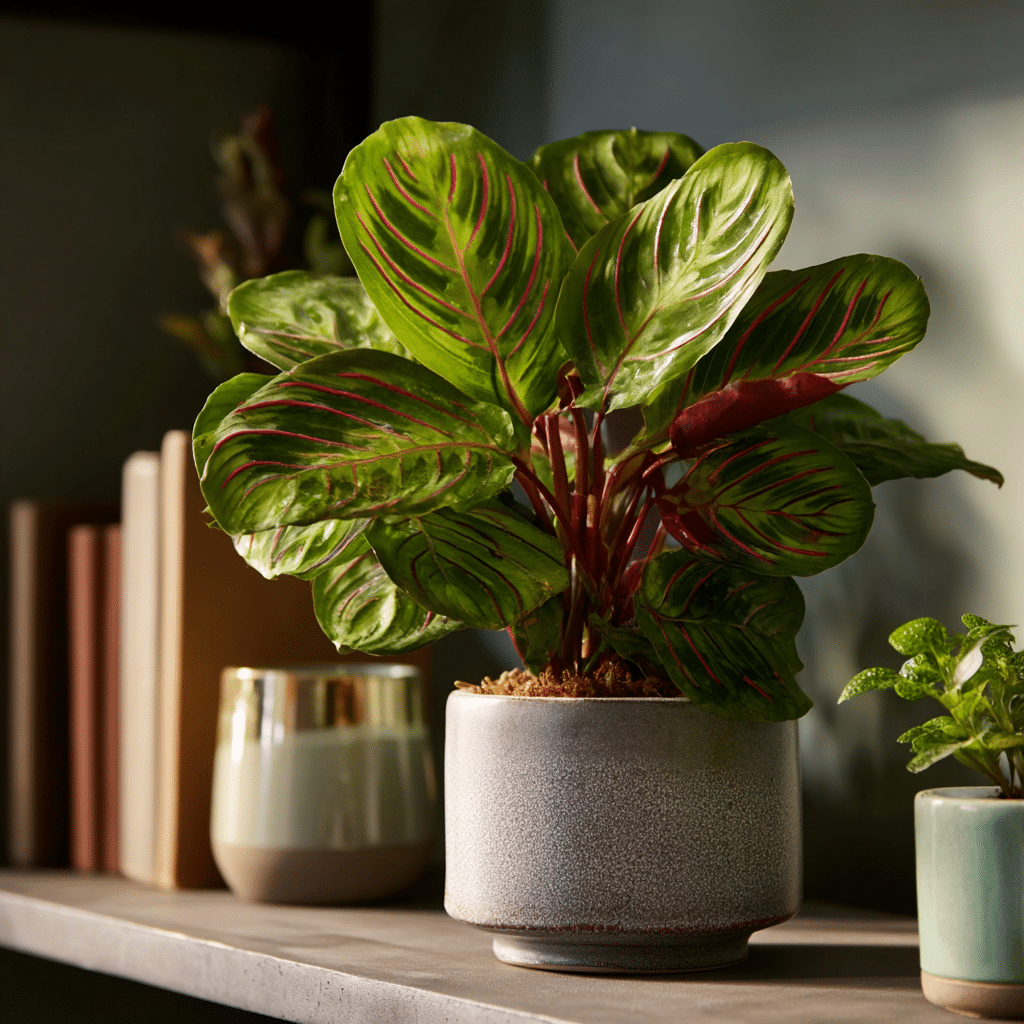
The Prayer Plant earns its name from a unique behavior—its leaves fold upward at night, resembling hands in prayer. Beyond this quirky trait, it’s one of the most visually interesting tropical plants, thanks to its deep green leaves patterned with red or pink veins and lighter splotches.
Prayer Plants prefer bright to medium indirect light and appreciate consistent moisture and high humidity. They’re perfect for terrariums, bathrooms, or kitchens where the air is naturally more humid. Use filtered water or let tap water sit overnight to avoid leaf spotting from minerals.
These compact plants are easy to care for if you meet their humidity needs, and they’re non-toxic, making them safe for curious pets and kids.
Quick Care Tips:
- Light: Bright to medium indirect
- Water: Keep soil evenly moist; high humidity needed
- Size: 6–12 in. tall and wide
- Difficulty: Low-maintenance
- Toxicity: Non-toxic
19. Amazonian Elephant’s Ear (Alocasia x amazonica)
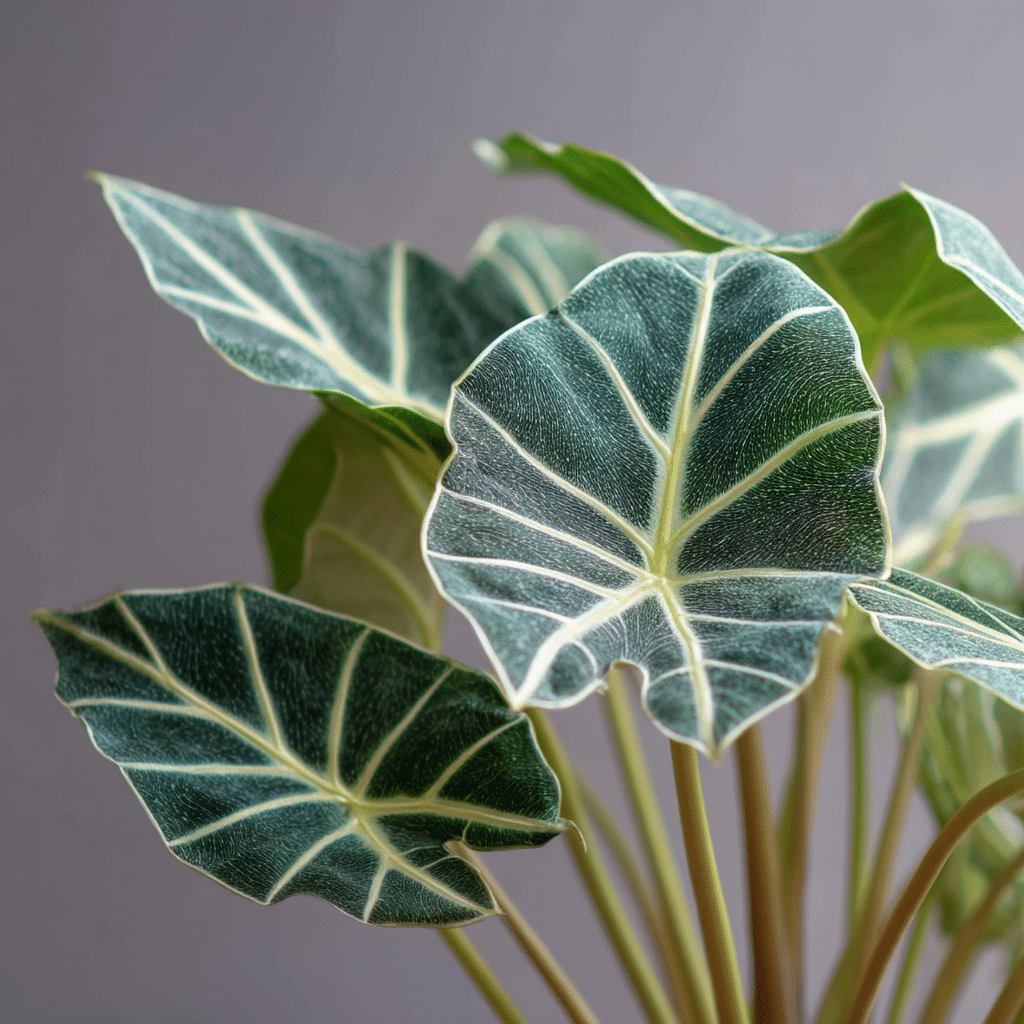
If you’re looking to make a bold statement with tropical plants, the Amazonian Elephant’s Ear is hard to beat. Its dramatic, arrow-shaped leaves have deep green coloring with bold silver or white veins—perfect for adding a regal, exotic vibe to any indoor space.
This Alocasia variety prefers part shade or filtered sunlight and thrives in a warm, humid environment. Use a rich, fast-draining potting mix and keep the soil consistently moist—but not soggy. Alocasia is sensitive to overwatering, so good drainage is essential.
Though it may go dormant in winter, it will return with fresh growth in spring if kept warm. Note that this plant is toxic to pets and people if ingested.
Quick Care Tips:
- Light: Part shade or filtered light
- Water: Keep soil moist but not wet
- Size: 1–2 ft. tall and wide
- Difficulty: Moderate
- Toxicity: Toxic to pets and humans
20. Goldfish Plant (Columnea gloriosa)
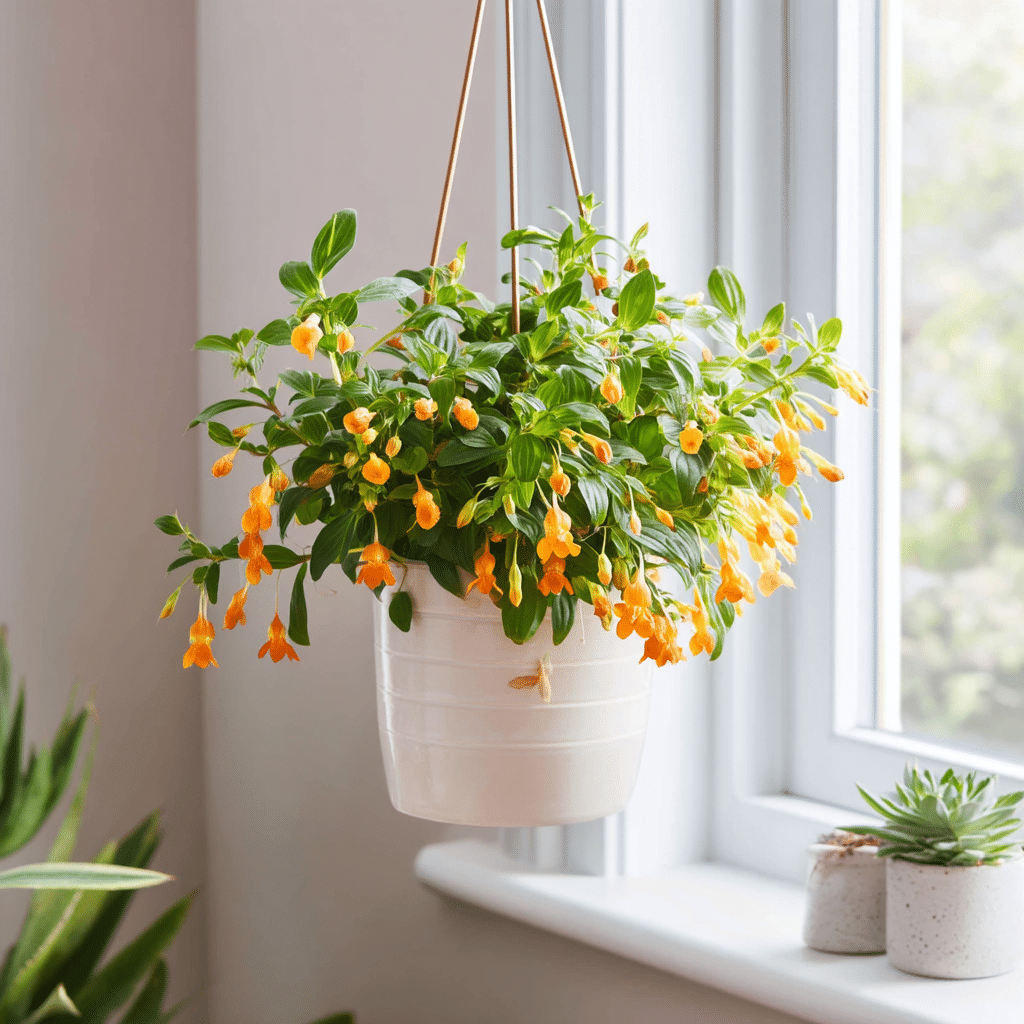
Playful and eye-catching, the Goldfish Plant gets its name from its tubular orange or yellow blooms that resemble tiny leaping goldfish. It’s one of the more whimsical tropical plants, ideal for hanging baskets where its trailing stems and flowers can truly shine.
This plant prefers bright, indirect light and does best in warm, slightly humid environments. It enjoys regular watering during the growing season (spring through summer), with reduced watering in the winter when it enters dormancy. Use a well-draining potting mix to prevent soggy roots.
Though it may not flower year-round, its glossy foliage makes it attractive even without blooms. It’s also generally considered non-toxic, making it safer around pets and kids.
Quick Care Tips:
- Light: Bright, indirect
- Water: Water regularly in growing season; reduce in winter
- Size: 2–3 ft. long, 2 ft. wide (trailing)
- Difficulty: Low-maintenance
- Toxicity: Non-toxic
Conclusion
Bringing tropical plants indoors is one of the easiest ways to infuse your home with life, color, and a touch of the exotic. Whether you prefer low-maintenance varieties like the ZZ Plant and Ponytail Palm or want to challenge yourself with showstoppers like the Bird of Paradise or Fiddle Leaf Fig, there’s a tropical plant for every space and skill level.
With the right lighting, humidity, and a little attention, these indoor beauties can thrive year-round, transforming your home into a personal jungle escape.
Looking to expand your indoor garden? Don’t miss our guides on:

